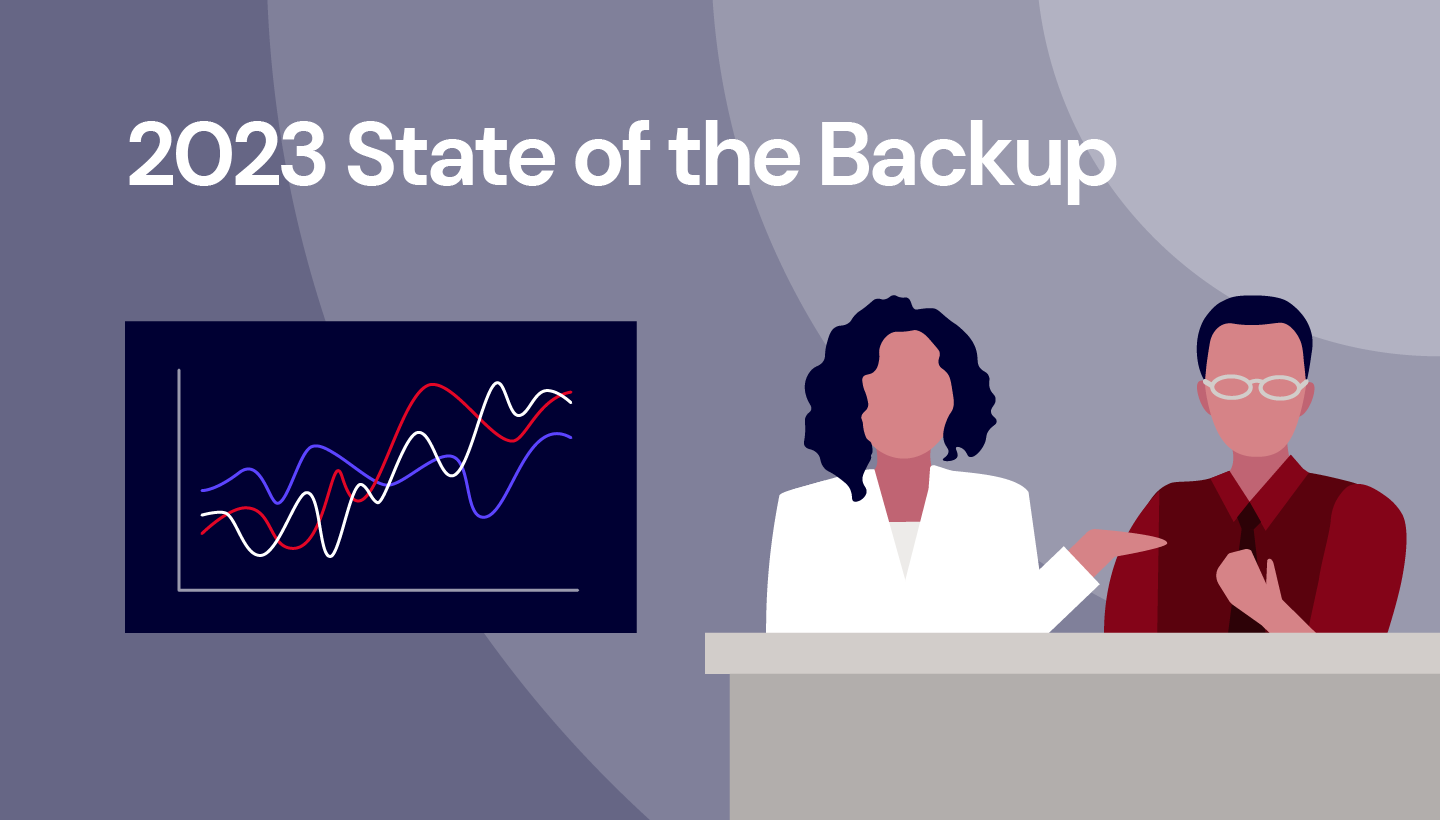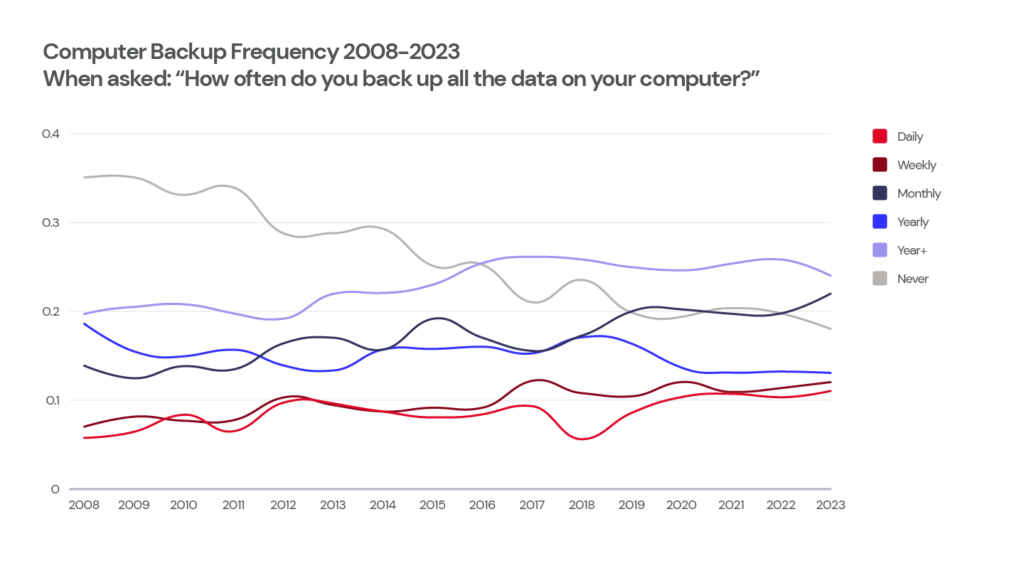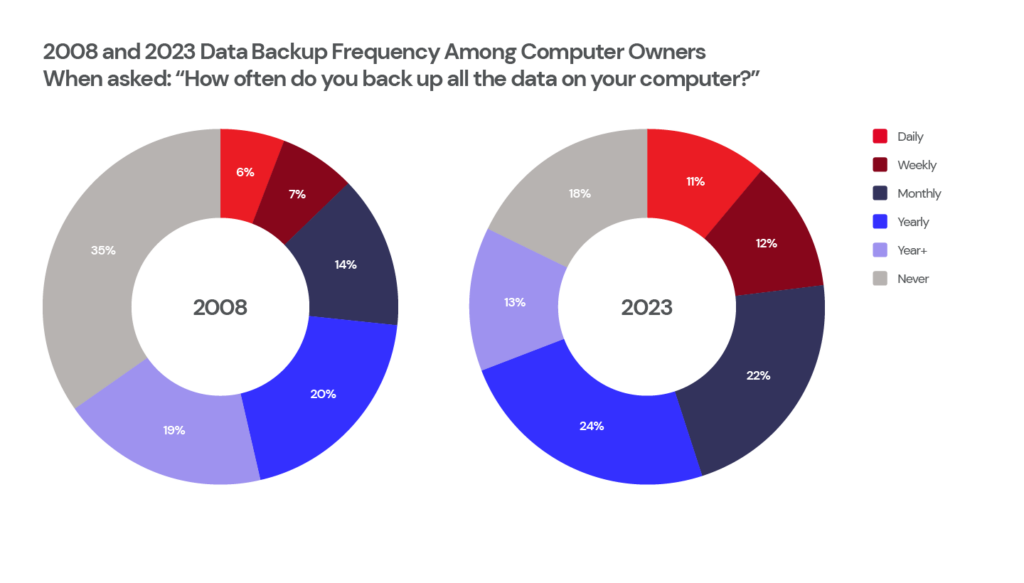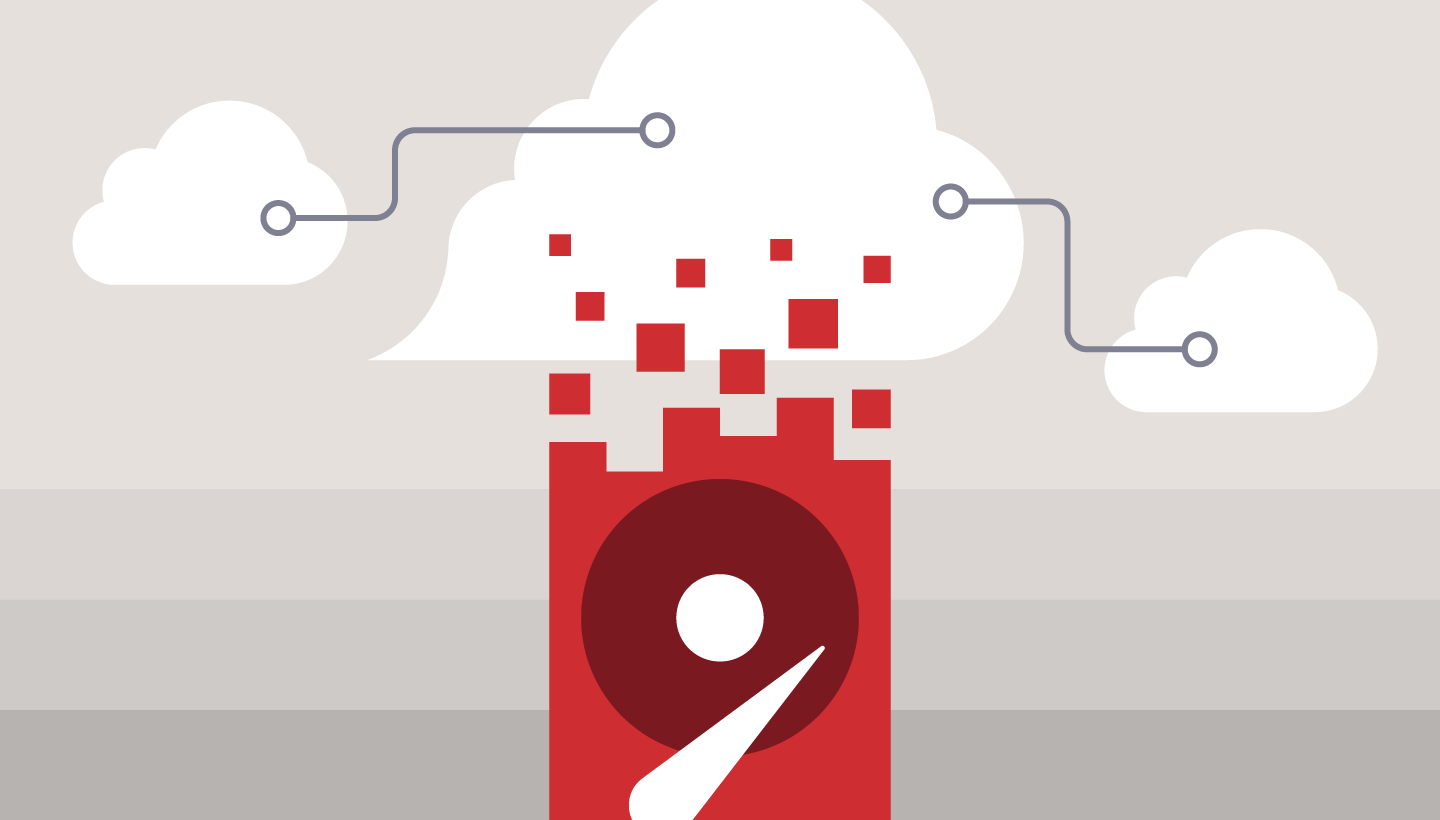
Each passing year brings with it a June, and with that comes a Backup Awareness Month. For those that are new to the blog, each June we partner with The Harris Poll to gauge the state of backups in the United States, by asking the simple question: “How often do you back up all the data on your computer?” (And a handful of other questions, too.) This post marks our survey’s 15th anniversary, and as you can imagine, the backup world has changed a lot in that time.
If you’ve followed our previous State of the Backup articles, you’ll know that we usually have a burning question that we want to answer. In 2021 and 2022, we were interested in the “best backer upper.” This year’s focus touches on the different “cloud” services that respondents use, and their confidence level that those services are providing them with the protection they crave—nay, deserve.
And that’s not just our (totally) normal love of backup coming out. It comes as news to no one that the world has shifted to a more digital environment, the ways we store, use, and manage data have changed. We have our data at more touchpoints in our lives, and cloud-based sync services are readily available. Being able to capture a full backup for all those various uses—business and personal—means that the need for automatic, unlimited solutions that you can access from anywhere is no longer a “nice to have.” It’s essential.
Backup Frequency Trends for 2023
This is one of my favorite graphs. Now with 15 years of data, we look at our headline question: How often do you back up all the data on your computer? This year we’re pleased that daily backups have not decreased and remain at similar levels to last year. In 2023, 11% of Americans who own a computer backed up their data at least once a day compared to 10% in 2022 and 11% in 2021. Weekly (8% in 2023 and 7% for both previous years) and monthly (15% in 2023 and 13% and 14% in the two previous years) backups among those who own a computer are similar to the past years as well.
The number of people who have never backed up data also remains at similar levels, with 18% of Americans who own a computer saying they’ve never backed up data in 2023 compared to 20% saying the same in the prior two years.
If you’ve hung around the Backblaze blog before, you likely have heard me (Yev) saying that the main competitor we have to our computer backup service is apathy. While we’re not (yet) seeing a statistically significant drop in those “never” numbers, we love to see that this category isn’t growing. And, we’ve got big plans to get more folks backing up in the future—we love using polls like this to learn more about how to move the needle. You can see from the graph below that, if you compare to 2008, we’ve certainly seen change over time.

Since some people prefer the raw data, and you can find it here, lovingly copied from Google Sheets:

While we’re past March 14, Pi Day is one of my favorite holidays to celebrate and also one of my favorite chart types. Here we have pie charts comparing the 2008 to 2023 data:

We love seeing the daily section growing while the never section shrinks—that’s progress. And, like we stated above, we view it as a big indicator of the massive shift in the ways people are using data.
Of course, we would love to see the daily backups skyrocketing year over year, because at the end of the day, if people aren’t backing up frequently, they are at risk of losing at least that day’s worth of data, which is one of the things that Backblaze Computer Backup is trying to help people avoid.
The Title of “Best” at Backing Up Is Up For Grabs
A few years ago we got curious about who is “best” at backing up. In 2021, we saw some statistical significance that indicated women between 35-44 years of age (21% likely to backup versus 9% of those 18-34 and 6% of those 55-64), and those who live in the Western United States (17% more likely to back up vs. the South and Midwest at 9% and 7%, respectively) were more likely to be computer owners who backed up once a day or more. When we checked in 2022, we found no statistical difference between the categories—but, we’ll explain why we keep checking in on this profile.
It’s worth taking a time-out for a stats mini-lesson, because we Backblaze plebeians did see some interesting fluctuations in the data, and the awesome experts at The Harris Poll let us know that these fluctuations are to be expected. Here’s why: When you’re talking about surveys rather than a census of a group, there is a sampling error that is expected just because you get a different group of people responding over time. We do statistical testing to see if the fluctuation could be due to chance (we just randomly got a different group of people) or if something has really changed in the group over time. In our survey, performed with 95% confidence, that means if we collected the survey 100 times we would report differences that would only occur in five of those surveys by chance assuming no change in the group. (Here’s an article that explains in more detail, if you’d like to dig in.)
The TL:DR of all that is that for a category to show statistical significance, it needs to be 5% greater or less than the total average of the parent category. In our parent category of computer owners who back up once a day or more,” we have a total average of 11% for 2023. Women between the ages of 35–44—clock in at 15%. So, while that’s not statistically significant, it’s certainly worth monitoring in our future surveys.
And that means that this year, the title is up for grabs! Get geared up for next year, folks: We love healthy competition about better backups.
Cloud Services Are All Around
When we started Backblaze 16 years ago, Amazon AWS had only recently started marketing Amazon Elastic Cloud Compute (in 2006, folks). Now, “the cloud” is a household name although it’s something of an amorphous concept for many—but there’s no denying that the cloud is accessible to consumers and companies alike.
Here are some indicative stats:
- Nearly two in three Americans (65%) who have backed up all the data on their computer use a cloud-based system as their primary backup method.
- Those who use the cloud services backup (63%), drive (67%), or sync (62%) to back up their computers are much more likely to say their backup method automatically backs up all the data on their computer than those who use an external hard drive (36%).
- Those who use a cloud backup service are more likely to say they had to recover, access, or restore lost data from their computer in the past month than those who use a cloud drive service, cloud sync service, or external hard drive (18% vs. 9% and 7% each).
Some of these facts reveal very important questions about backup and sync in relation to our backup questions. We’ve talked about the differences in the past, and here we see folks who are saying that they use a drive or sync service as their backup method.
So, when those Americans using cloud-based systems think they’re backing up each day, in all likelihood, at least some of them are describing another type of data storage—syncing data across devices or storing data on a cloud drive. But, without an additional copy of your data, you aren’t truly backing up.
Still, even with more people backing up, overall data confidence is low, with fewer than one in five Americans (17%) stating they are absolutely certain that their most important computer files are safely backed up somewhere. Even more telling? 12% of Americans who use a cloud service, external hard drive, or a network attached storage (NAS) as a primary method to back up data say they are not confident the method they use is set up to protect all of the data on their computer.
That number means we need to get more people not only backing up but testing their restores. If you’ve never tested your restores, we highly recommend it. Not only does it let you see exactly where you’re storing your files and what it takes to restore them, but it also shows you how long it will take to get your files back online in the event of data loss. It’s also one of the main differentiators between “cloud” services—the ease with which you can get all your data back is a good selection criteria.
In Recovery Situations, A Plan Makes All the Difference
The whole point of a backup is to make sure that you never lose critical data. We certainly want and value this for personal recovery—check out our article about how a digital go bag can help you prepare for natural disasters and the like.
But, if you’re a business owner, any disruption in data or file loss can mean that your business is off-line. Business continuity plans help you understand how to get back online with minimal stress and as soon as possible. Especially if you’re a small or medium-sized business, you know how important that is! Services like Instant Business Recovery are a great tool in that respect: They help your business prepare for scenarios in which you might have outages and to get back online as quickly as possible.
What Are Those Services Doing Anyway?
When looking at computer owners who use a cloud backup service like Backblaze as their primary backup we find that:
- 63% say their service automatically backs up all the data on their computer.
- 27% say it backs up only the data they select with no limitations.
- 9% say it backs up only the data they select but with some limits.
- 1% marked “other.”
- 1% are not sure at all.
Why is this important? Well, different types of backups mean that you can recover things in different ways. For instance, a bare metal recovery is designed to take you from a computer with nothing on it—not even an operating system—to a fully-functional computer with all your files. Does your backup service support those file types?
Another example: a grandfather-father-son or a full vs. incremental backup may help you save valuable storage space when it comes to backing up (especially when your backup service may have limits or charge you based on storage space, as some folks indicate above).
Finally, our old pal, the 3-2-1 backup strategy, recommends both an on-site and an off-site copy of your data, which means that whichever method you use to backup, you’re going to want to store those backups in different and accessible ways.
It’s not only a question of knowing if your backup service is automatically backing up all the data on your computer—you also want to know where that data is being stored, what file types are supported, if or how you need to set “rules,” and more. There are positives and negatives to each backup strategy, of course, but the numbers above show us that we have some work to do to help people know where to start when it comes to building an effective plan. We see a detailed education campaign about what Backblaze backs up brewing in our future!
Backing Up Remains Paramount
When looking at the data loss statistics of Americans who own a computer:
- 70% report accidentally deleting something.
- 54% report having lost data.
- 54% were affected by a security incident (like ransomware or malware).
- 46% had an internal or external hard drive crash.
- 36% of those who did had crashes happen within the last year.
- 45% lost access to their data when a shared drive or synced drive was deleted.
This year over half of Americans who own a computer reported being affected by a security incident, and that number is in line with last year (54% this year vs. 53% last year). Over the years, ransomware has increasingly become a “when, not if” situation, which means that seemingly simple things, like making strong passwords, using virtual private networks (VPNs), and knowing how to recognize a phishing attack are more important than ever. Prevention is only half the battle of course—and a good backup and recovery plan is the other.
What’s more, these things become even more interesting when you think about data loss as it comes to our working environment. As we see modern work patterns change, we see more people working on their home networks and using mobile phones. As the workplace has shifted to include more remote and hybrid environments, employers are having to think about what it looks like to secure data across dispersed locations. Not only do you have lots of folks working on software as a service (SaaS) tools that include synced or shared drives (and have their own backup strategy demands), but you also need to capture folks saving on their local drives—which means you need individual workstation backup to ensure that you have a complete disaster recovery (DR) plan in place.
Good Backups Get Personal
Fifteen years into this Harris Poll (and 16 years into being Backblaze!), we are still driven to understand the world of backup to support our ultimate goal: making storing and using data astonishingly easy. The work of taking these disparate data points (70% of Americans who own a computer have accidentally deleted something) and turning them into solutions (hey, an automatic backup means that you can get it back) is something we can’t do without understanding the world and how it changes.
And, this is true on an individual level, too. When you’re building your backup solution, what you need for your personal backups is likely to be different from what you’ll need for your job. Maybe a network attached storage (NAS) device lets you bring all of your family’s household devices to a single place to manage and backup data, keeping you away from those pesky iCloud data storage limits. If you own a business, maybe you want to consider how long to keep your backups and how much it costs to store data in different formats like on hard drives or in the cloud.
We hope you enjoy seeing the big picture as much as we do, and we hope this information ultimately helps you to find the best backup service for your data. Jump into the comments and let us know what you think!
Survey Method:
This year’s survey was conducted online within the United States by The Harris Poll on behalf of Backblaze from April 25–27, 2023, among 2,050 adults ages 18+, among whom 1,857 own a computer. The sampling precision of Harris online polls is measured by using a Bayesian credible interval. For this study, the sample data is accurate to within +/- 2.8 percentage points using a 95% confidence level.
Prior year’s surveys were conducted online by The Harris Poll on behalf of Backblaze among U.S. adults ages 18+ who own a computer in May 19–23, 2022 (n=1,861); May 12–14, 2021 (n=1,870); June 1–3, 2020 (n=1,913); June 6–10, 2019 (n=1,858); June 5–7, 2018 (n=1,871); May 19–23, 2017 (n=1,954); May 13–17, 2016 (n=1,920); May 15–19, 2015 (n=2,009); June 2-4, 2014 (n=1,991); June 13–17, 2013 (n=1,952); May 31–June 4, 2012 (n=2,176); June 28–30, 2011 (n=2,209); June 3–7, 2010 (n=2,051); May 13–14, 2009 (n=2,154); and May 27–29, 2008 (n=2,723).
For complete survey methodologies, including weighting variables and subgroup sample sizes, please contact Backblaze.




